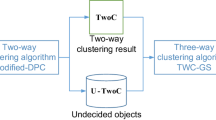Abstract
Existing clustering algorithms use distance, density or concept as clustering criterion. These criterions can not exactly reflect relationships among multiple objects, so that the clustering qualities are not satisfying. In this paper, a mechanics based clustering algorithm is proposed. The algorithm regards data objects as particles with masses and uses gravitation to depict relationships among data objects. Clustering is executed according to displacements of data objects caused by gravitation, and the result is optimized subjecting to Minimum Potential Energy Principle. The superiority of the algorithm is that the relationships among multiple objects are exactly reflected by gravitation, and the multiple relationships can be converted to the single ones due to force composition, so that the computation can be executed efficiently. Experiments indicate that qualities of the clustering results deduced by this algorithm are better than those of classic algorithms such as CURE and K-Means.
Preview
Unable to display preview. Download preview PDF.
Similar content being viewed by others
References
Guha, S., Rastogi, R., Shim, K.: Cure: An efficient clustering algorithm for large databases. In: Proceedings of the ACM SIGMOD Conference, pp. 73–84. ACM Press, New York (1998)
Karypis, G., Han, E.-H., Kumar, V.: Chameleon: A hierarchical clustering algorithm using dynamic modeling. Computer 32, 68–75 (1999)
Zhang, T., Ramakrishnan, R., Livny, M.: Birch: an efficient data clustering method for very large databases. In: Proceedings of the ACM SIGMOD Conference, pp. 103–114. ACM Press, New York (1996)
Fisher, D.: Knowledge acquisition via incremental conceptual clustering. Machine Learning 2, 139–172 (1987)
Savaresi, S., Boley, D.: On performance of bisecting k-means and PDDP. In: Proceedings of the 1st SIAM ICDM, SIAM, Philadelphia (2001)
Hartigan, J.: Clustering Algorithms. John Wiley & Sons, Chichester (1975)
Hartigan, J., Wong, M.: A k-means clustering algorithm. Applied Statistics 28, 100–108 (1979)
Ng, R., Han, J.: Efficient and effective clustering methods for spatial data mining. In: Proceedings of the 20th Conference on VLDB, pp. 144–155 (1994)
Kaufman, L., Rousseeuw, P.J.: Finding groups in data: An introduction to cluster analysis. John Wiley & Sons, New York (1990)
Sheikholeslami, G., Chatterjee, S., Zahng, A.: WaveCluster: A multi-resolution clustering approach for very large spatial databases. In: Proceedings of the 24th Conference on VLDB, pp. 428–439 (1998)
Wang, W., Yang, J., Muntz, R.: STING: a statistical information grid approach to spatial data mining. In: Proceedings of the 23rd Conference on VLDB, pp. 186–195 (1997)
Agrawal, R., et al.: Automatic subspace clustering of high dimensional data for data mining applications. In: Proceedings of the ACM SIGMOD Conference, pp. 94–105. ACM Press, New York (1998)
Ester, M., et al.: A density-based algorithm for discovering clusters in large spatial databases with noise. In: Proceedings of the 2nd ACM SIGKDD, pp. 226–231. ACM Press, New York (1996)
Ankerst, M., et al.: OPTICS: Ordering points to identify clustering structure. In: Proceedings of the ACM SIGMOD Conference, pp. 49–60. ACM Press, New York (1999)
Xu, X., et al.: A distribution-based clustering algorithm for mining large spatial datasets. In: Proceedings of the 14th ICDE, pp. 324–331 (1998)
Yu, J., Cheng, Q.-s.: The searching range with the best clustering number of the fuzzy clustering methods. China Science 32(2), 274–280 (2002)
Long, Y.-q., Bao, S.-h.: Structural mechanics I,II. Higher education publishing house (2000)
Sun, X.-f., Fang, X.-s., Guan, L.-t.: Mechanics of material (First volume and Secodn volume). Higher education publishing house (2000)
Author information
Authors and Affiliations
Editor information
Rights and permissions
Copyright information
© 2007 Springer Berlin Heidelberg
About this paper
Cite this paper
Zhang, X., Jiang, H., Liu, X., Yu, H. (2007). A Clustering Algorithm Based on Mechanics. In: Zhou, ZH., Li, H., Yang, Q. (eds) Advances in Knowledge Discovery and Data Mining. PAKDD 2007. Lecture Notes in Computer Science(), vol 4426. Springer, Berlin, Heidelberg. https://doi.org/10.1007/978-3-540-71701-0_36
Download citation
DOI: https://doi.org/10.1007/978-3-540-71701-0_36
Publisher Name: Springer, Berlin, Heidelberg
Print ISBN: 978-3-540-71700-3
Online ISBN: 978-3-540-71701-0
eBook Packages: Computer ScienceComputer Science (R0)




